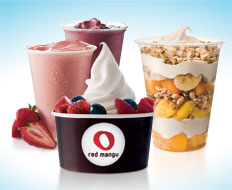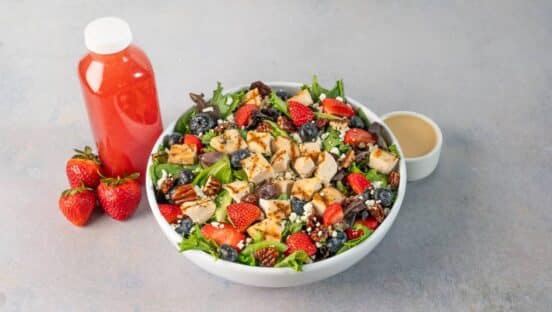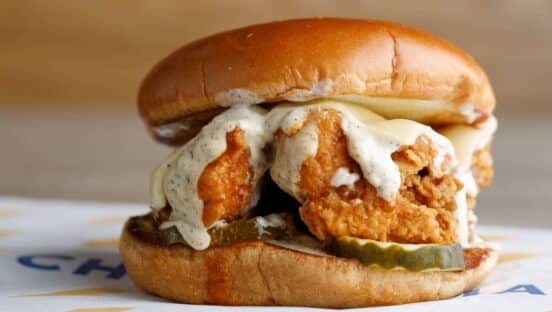Frozen yogurt has always been categorized as an “ice cream substitute,” Red Mango president Dan Kim says, but he differentiates his company’s product not by what it isn’t, but by what it is. Kim describes Red Mango’s product as a tart, refreshing, all-natural nonfat yogurt with calcium, protein, and a patented strain of probiotics to support the immune system and regulate the digestive system.
“Growing up in an Asian family, I had a good understanding of what yogurt is—how healthy it is,” Kim says. “The challenge going into new markets is that we have to educate customers as to what yogurt really tastes like.”
Red Mango can be viewed as a place to get a healthy treat, or, now with the March addition of parfaits and smoothies, a meal.
Kim took the Red Mango brand, which started in Korea but struggled there, tweaked it, and introduced it to the U.S. at a store near the UCLA campus in 2007.
“Because of my experience in marketing and branding, colleagues asked me to start a company here with the Red Mango brand,” Kim says. “My initial reaction was no, it was such a crowded space, but as I explored it further I thought it was a segment where I could innovate.”
From that first store the concept expanded to five by the end of the year. In 2008, former Taco Bell executive John Antioco was ready to step down from his position at Blockbuster and became an adviser to Red Mango. He helped grow the brand to 20 stores by April 2008. That year, Dallas-based private equity firm CIC Partners invested and grew the chain to 60 stores.
Kim says Red Mango began aggressively franchising in 2009. The company offered an unusual franchising program that offered a money-back guarantee to franchisees who weren’t satisfied with their investment. Nobody has taken it up on its offer.
While 2009 was a difficult year economically, financing started to loosen up for potential franchisees and this year Kim hopes to launch another 30–40 stores. Red Mango has stores operating or scheduled to open in 20 states.
“We have planned growth in key markets like New York, but if a good operator comes along who has a passion for the brand and can prove to us they can grow the brand, we’ll go outside those markets,” he says.
Red Mango appeals to kids and adults alike with frozen yogurt flavors that include Original, described as “sweet and tangy,” as well as Pomegranate by POM Wonderful, the citrus-flavored Tangomonium, and a seasonal flavor, which now is Madagascar Vanilla. All weigh in at about 100 calories per half-cup serving.
A variety of toppings make for countless combinations. Nine fresh fruit choices are always available, as well as nine “fun and crunchy” toppings that range from organic granola and sliced almonds to Cap’n Crunch and graham crackers.
Red Mango
PRESIDENT: Dan Kim
HQ: Dallas
YEAR STARTED: 2007
ANNUAL SALES: $20 million
TOTAL UNITS: 60
FRANCHISE UNITS: 50
To make the recently launched smoothies, frozen yogurt is layered with granola and fruit in the Mixed Berry and Tropical Fruit parfaits and blended with fruit, ice, and a zero-calorie stevia sweetener.
Iced tea was the latest addition to the Red Mango menu. The probiotic teas are available in Lemonocity (lemonade green tea), Mysteaque (vanilla black tea), and Fanteasia (wildberry hibiscus tea featured in QSR’s February Inspirations section), and all are less than 100 calories per serving.
Kim says about 70 percent of Red Mango customers are women and calorie counts are important to them.
“We make sure everything we do is transparent to the customer—ingredients, calories, nutrition—because women read labels.”
It’s not just nutrition facts that set Red Mango apart from other frozen-dessert sellers, Kim says. It’s the atmosphere of the stores, too.
“We put a real emphasis on design because we want to create an environment people can immerse themselves into and relax, not just rush in and out,” he says. “It’s like lounge meets coffee shop meets frozen-dessert shop.”
Red Mango stores come in several formats, including traditional stores, kiosks, cobranded locations, and self-serve destinations. In April, Red Mango awarded a license agreement to airport concession operator The Grove Inc. to offer Red Mango in U.S. airports including Chicago’s O’Hare International Airport, Newark Liberty International Airport, and New York City’s LaGuardia International Airport.
A traditional Red Mango store is 1,000–1,300 square feet. Self-serve stores need a bit more space and range from 1,500 to 2,000 square feet. Kiosks and cobranded locations are smaller.
A typical customer spends $5–$8 at a Red Mango, and when they aren’t actually enjoying the frozen treat, customers seem to enjoy Kim’s Facebook and Twitter pages, where he posts coupons, opportunities to win free yogurt, and suggests flavor combinations.
“It’s so much fun,” he says of marketing his business through social networking. “And I can do it right from my phone.”











